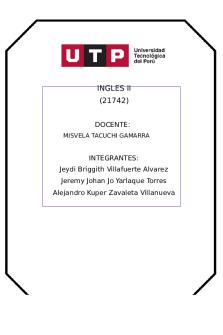Week 6 Blended Learning Models PDF

| Title | Week 6 Blended Learning Models |
|---|---|
| Course | Introduction to Educational Technology |
| Institution | University of Alberta |
| Pages | 3 |
| File Size | 81.4 KB |
| File Type | |
| Total Downloads | 35 |
| Total Views | 129 |
Summary
Download Week 6 Blended Learning Models PDF
Description
Week 6 Blended Learning & Online activities notes: What is blended learning? o “Blended learning is a teaching approach where both traditional face-to-face instructional time and online computer-mediated activities are integrated.” – Centre for Teaching and Learning, UofA o Meant to compliment one another Can vary widely from classroom to classroom Sloan consortium blended range = 30-80% Five Blended Learning Models 1. Face to Face a. Best for traditional style teachers b. Closest model to lecture-style c. Online instruction provides supplemental resources i. Introduced for students that are behind to engage and supplement in the inclass lessons ii. Online instruction is used alongside traditional teaching to increase success in educational outcomes 2. Self-Blend a. Students opt to take online courses outside of the time that they traditionally spend at school b. Allows students to take subjects that are not offered by their school district i. Most often used in high schools because it allows the students to take initiative ii. Allows them to go beyond their own school and assist in honing their digital literacy skills c. Students may take courses due to interest i. Students are the main drivers d. Often seen in rural communities 3. Rotation a. (Within their given courses) Students rotate on a fixed schedule between online, self-paced activities, and face-to-face learning i. Most in between F2F and online learning ii. Involves a split between the two b. Face-to-face teacher usually oversees the online work 4. Flex a. Allows for asynchronous learning or learning that takes place at the student’s own pace
b. Assignments are completed independently on computers c. Students work at their own pace – have as much or as little time as they want d. Teacher supervises everything and provides one-on-one or group instruction when needed 5. Online Driver a. Most reliant on technology b. Teacher takes facilitator role – helps students online when needed, either on demand or at a grade times c. Students can decide where they would like to work from d. All instruction is completed through virtual channels e. May only meet instructor in-person during their exams – all other meetings done via web-conferencing With these models, in some cases students have the schedule to follow, while others they are allowed to work at their own pace Synchronous Learning o A learning event where the learner and instructor are in the same place at the same time o Meeting students at set times and dates o Face-to-Face o Online instruction – meeting with your class in a web conferencing room allows for synchronous learning to take place o Materials such as assignments, readings, and quizzes have set deadlines o Students can interact with fellow students or instructor o Online often occurs via web conferencing software
Asynchronous Learning o Not being synchronous. Where there is no time requirement for transmission of information – UofMassachusetts o Coursework can be delivered via the web, email, and LMS, or forums o Allows for the students to have a self paced learning environment More online a course is – the more asynchronous it is The more f2f = more synchronous
Blended learning is a spectrum – can be applied in many different ways But blended learning does have detractors like: o Budget and infrastructure – software can be costly o Technology failure – its bound to fail, ensure you have back up lessons available o Burn Out – teacher must have a clear vision of what and how you’re going to blend your course o Plagiarism and Copyright o Privacy and Security – 3rd part program need to be ensured they are able to be used...
Similar Free PDFs

Week 6 Blended Learning Models
- 3 Pages

Active Blended Learning
- 22 Pages

Week 6 Week 6 Week 6Week 6
- 2 Pages

Week 6 ingles Week 6
- 2 Pages

Week 6 Assignment - Week 6
- 11 Pages

Blended Families
- 15 Pages

Week 4 Learning Journal
- 2 Pages

Learning journal week 2
- 4 Pages

Blended-Family-Structure
- 3 Pages
Popular Institutions
- Tinajero National High School - Annex
- Politeknik Caltex Riau
- Yokohama City University
- SGT University
- University of Al-Qadisiyah
- Divine Word College of Vigan
- Techniek College Rotterdam
- Universidade de Santiago
- Universiti Teknologi MARA Cawangan Johor Kampus Pasir Gudang
- Poltekkes Kemenkes Yogyakarta
- Baguio City National High School
- Colegio san marcos
- preparatoria uno
- Centro de Bachillerato Tecnológico Industrial y de Servicios No. 107
- Dalian Maritime University
- Quang Trung Secondary School
- Colegio Tecnológico en Informática
- Corporación Regional de Educación Superior
- Grupo CEDVA
- Dar Al Uloom University
- Centro de Estudios Preuniversitarios de la Universidad Nacional de Ingeniería
- 上智大学
- Aakash International School, Nuna Majara
- San Felipe Neri Catholic School
- Kang Chiao International School - New Taipei City
- Misamis Occidental National High School
- Institución Educativa Escuela Normal Juan Ladrilleros
- Kolehiyo ng Pantukan
- Batanes State College
- Instituto Continental
- Sekolah Menengah Kejuruan Kesehatan Kaltara (Tarakan)
- Colegio de La Inmaculada Concepcion - Cebu






